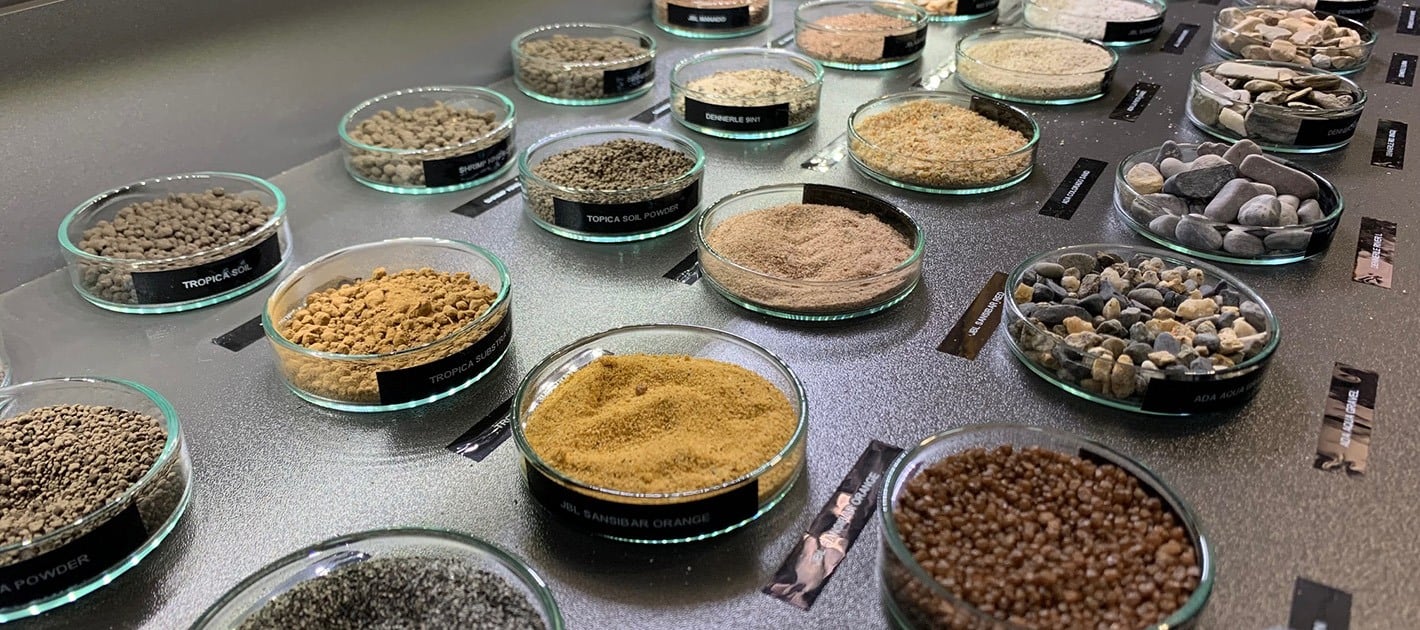Substrate
Aquarium Substrates: Choosing the Right Base for Your Aquatic World
Choosing the right substrate is a crucial yet often overlooked aspect of aquarium design. Substrate affects not only the appearance of your tank but also water chemistry, plant growth, fish health, and ease of maintenance. Whether you’re setting up a planted aquascape, a community tank, or a breeding setup, the type of substrate you choose can make a significant difference.
This guide explores four popular aquarium substrate types—sand, gravel, bare bottom, and slate tiles—and discusses the pros and cons of each to help you make an informed decision.
1. Sand Substrate

Sand is a popular choice in both freshwater and marine aquariums. It comes in various grades and colours, including natural river sand, play sand, and aquarium-specific products like aragonite or black diamond blasting sand.
Pros:
- Natural appearance: Mimics many natural habitats such as riverbeds and lake floors, especially for bottom-dwelling fish.
- Good for burrowing species: Ideal for fish such as corydoras, loaches, and certain cichlids that like to sift or dig.
- Prevents food debris from sinking in: Waste sits on top, making it easier to siphon away during cleaning.
Cons:
- Poor water circulation: Compacts easily, potentially leading to anaerobic pockets that produce toxic gases if not stirred occasionally.
- Can clog filters: Fine particles may get sucked into filters if not pre-rinsed or managed carefully.
- Challenging for rooted plants: Unless enriched or mixed with a nutrient layer, it offers poor anchorage and nutrient supply for plant roots.
2. Gravel Substrate

Gravel is one of the most commonly used substrates in freshwater aquariums. It is available in a wide range of sizes (fine to coarse) and colours, from natural pebbles to brightly dyed varieties.
Pros:
- Excellent water flow: Encourages better circulation through the substrate, reducing the chance of toxic gas build-up.
- Suitable for planted tanks: Provides a stable base for plant roots, especially when combined with root tabs or soil underneath.
- Long-lasting and easy to clean: Does not break down over time and is simple to vacuum with a siphon.
Cons:
- Traps waste and debris: Uneaten food and detritus can settle between gravel particles, requiring regular deep cleaning.
- Unsuitable for some bottom dwellers: Sharp or rough gravel may damage sensitive fish like corydoras or plecos.
- Artificial colours may leach: Some cheap dyed gravels can degrade or affect water quality if not aquarium-safe.
3. Bare Bottom Aquarium

A bare bottom tank has no substrate at all—just the glass bottom. This setup is commonly used in breeding tanks, hospital tanks, or high-maintenance aquariums where cleanliness is paramount.
Pros:
- Very easy to clean: Waste and debris are highly visible and can be siphoned out with minimal effort.
- Ideal for breeding or quarantine tanks: Reduces bacteria build-up and allows close observation of fish health and behaviour.
- No substrate-related issues: No risk of anaerobic zones or substrate compaction.
Cons:
- Unnatural look: Lacks the aesthetic appeal of a natural environment and can appear stark or clinical.
- Not suitable for plants: Most aquarium plants need substrate to root, so only floating plants or potted options will work.
- May stress certain fish: Some species feel insecure without substrate to forage or hide in.
4. Slate Tile Bottom

Slate tiles offer a creative alternative to gravel or sand. Flat pieces of aquarium-safe slate are laid across the tank bottom, sometimes siliconed in place, to create a sleek, natural-looking floor.
Pros:
- Easy to clean: Like bare bottoms, slate tiles allow for easy waste removal while offering a more attractive look.
- Stable base for décor: Rocks and ornaments sit securely without shifting, reducing the risk of collapse.
- Visually appealing: Offers a dark, stone-like aesthetic that complements natural scapes and enhances fish colours.
Cons:
- Limited for plant growth: Slate is non-porous and doesn’t allow rooting unless combined with plant pots or external nutrient sources.
- Must be aquarium-safe: Non-aquarium-grade slate may leach minerals or contain sharp edges.
- Installation can be tricky: Tiles must be cut to size and laid flat to avoid trapping debris underneath.
Choosing the Right Substrate
When selecting a substrate, consider the type of fish you’re keeping, whether you intend to grow live plants, your tank size, and your preferred maintenance level. Here’s a quick comparison:
| Substrate Type | Best For | Main Advantages | Main Drawbacks |
|---|---|---|---|
| Sand | Bottom dwellers, natural scapes | Natural look, gentle for burrowing fish | Can compact, harder to vacuum |
| Gravel | Community tanks, planted tanks | Good water flow, easy to clean | Can trap waste, sharp edges on some types |
| Bare Bottom | Breeding tanks, hospital tanks | Maximum hygiene, easy maintenance | Unnatural look, no planting options |
| Slate Tiles | Show tanks, semi-planted tanks | Cleanable and decorative | Not ideal for rooted plants |
Final Thoughts
Substrate is more than just the floor of your tank—it influences everything from aesthetics and biological filtration to the well-being of your fish. By choosing the right substrate for your tank’s purpose and inhabitants, you lay a strong foundation for a thriving and beautiful aquatic ecosystem.
Whether you go with soft sand for bottom dwellers, practical gravel for planted tanks, a bare bottom for breeding, or elegant slate for design appeal, matching the substrate to your tank’s goals ensures long-term success.


